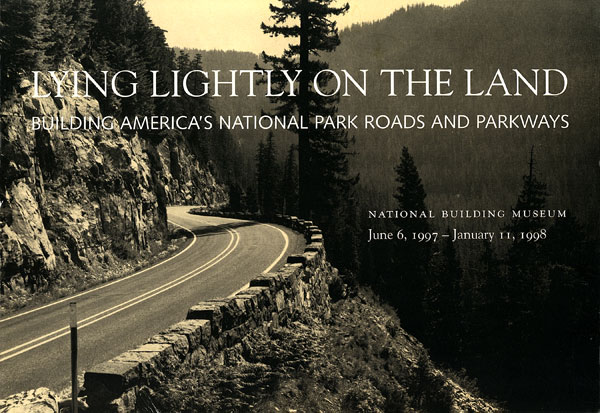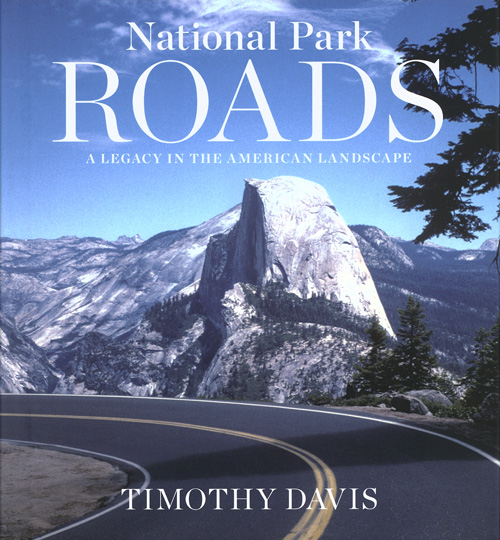 | |
 | |
 | |
 | |
 | |
 | |
 | |
 | |
 | |
 | |
 | |
 | |
 | |
 | |
 | |
 | |
 | |
 |
 |

INTRODUCTION
MILLIONS OF VISITORS TOUR America's national parks every year, but few pause to consider how, when, or why the roads they travel on were built. Lying Lightly on the Land calls attention to the unique characteristics of park roads — demonstrating the social, technological, and environmental factors involved in their development and encouraging informed debate about the future of America's park roads and parkways.
Park road development epitomizes the challenge of park management: how to protect America's natural and cultural resources while ensuring that visitors are able to enjoy them in comfort and safety. Though there will always be a precarious balance between preservation and access, park road builders have worked to find ways to provide access while minimizing the negative impact of roads on the sensitive environments they are designed to showcase and protect.
Touring Wonderland
Since the parks opened in the second half of the nineteenth century, roads and vehicles have provided the primary means of experiencing national parks. Early park visitors traveled by stagecoach along simple dirt roads constructed by private toll companies or the U.S. Army Corps of Engineers. Despite meager federal appropriations, primitive equipment, and difficult conditions, early park road builders accomplished many impressive construction feats ranging from Yellowstone's Golden Gate viaduct and the steep stage roads into Yosemite Valley to the winding Nisqually road on Mount Rainier. Stagecoach excursions through the early national parks were long and dusty outings — seeing the sights of Yellowstone could easily take a week or more — relieved by stays in grand hotels or primly maintained tent cabins. Touring the national parks in this manner was a privilege restricted to those who could afford the time and expense of lengthy vacations and costly accommodations.
Embracing the Automobile
The arrival of the automobile at the turn of the century presented park managers with new challenges and opportunities. A few pioneering motorists made their way into Yosemite as early as 1900, but automobiles were soon banned as threats to the peace and safety of visitors traveling by stagecoach. Aggressive lobbying by automobile interests, combined with the general desire to make parks more accessible to middle class Americans, led all national parks to open their gates to car traffic by 1915. Stagecoach companies rapidly switched from horse-drawn vehicles to gaily colored touring cars. In the 1920s, motor touring and car camping blossomed into nationwide fads, actively encouraged by the National Park Service in order to build a broader constituency of park supporters. Parks overflowed with motorists who regaled each other with tales of their automotive adventures traveling the rough and rugged park roads.
The Golden Age of Park Road Development
In order to accommodate the influx of motorists and their demands for modern, high-quality roads, landscape architects from the National Park Service worked with highway engineers from the U.S. Bureau of Public Roads to develop a systematic approach to road design, construction, and management. This collaborative effort produced a "Golden Age" of park road development that lasted from the mid 1920s until the outbreak of World War II. Bigger budgets and newer, more powerful machinery enabled the park road builders of the 1920s and 1930s to attempt more ambitious projects than their predecessors. These designers and engineers sought to reduce the visual impact of road construction, harmonize structures with the local environment, and lead visitors through an enjoyable series of visual experiences. To a large extent, the basic characteristics of today's National Park System were established during this period.
Among the outstanding projects of the era were the Going-to-the-Sun Road in Glacier National Park, the Zion-Mount Carmel Highway in Zion National Park, Shenandoah National Park's Skyline Drive, and the reconstruction of the major entrance roads into Yosemite National Park.
Parkways
Parkways were an important element of this "Golden Age" of park road development.
Designed as linear parks surrounding attractively laid-out motor roads, parkways enable motorists to enjoy mile after mile of attractive scenery without confronting the traffic hazards and commercial intrusions found on ordinary highways, Urban parkways, such as the George Washington Memorial Parkway, function largely as commuter rotes but often include picnic areas and scenic pullouts. The Blue Ridge and Natchez Trace Parkways provide miles of carefully maintained picturesque landscapes along with additional recreational features.
Trouble in Paradise
By the mid 1950s, increased prosperity, expanding leisure time, and rapidly improving interstate highways brought unprecedented numbers of motorists into the national parks, overwhelming facilities designed for the modest crowds of the pre-World War II era. These vacationers demanded more and better roads to accommodate larger vehicles and the growing desire for quick, comfortable, and easy access to scenic and historic features. In response to widespread public demand, the National Park Service launched Mission 66, a ten-year program designed to upgrade park facilities and expand and improve roads in time for the agency's 50th anniversary in 1966.
At the same time, an increased interest in wilderness preservation and ecological principles resulted in growing opposition to park road building. These competing concerns threatened to split the traditional National Park Service constituency between environmentalists, who actively opposed road development, and the tourist industry, which continued to push for highway improvements. By the late 1960s, the National Park Service gradually reoriented its policies to limit additional road construction, promote alternative modes of transportation, and continue to ensure that new roads and facilities would intrude as little as possible on park landscapes.
Building for the Future
The tensions between preservation and access play a prominent role in contemporary park road development, as park managers face everincreasing visitation, pressure to upgrade park roads according to modern safety standards, and opposing demands to minimize the impact of tourism on limited park resources. The growing awareness that many park roads and related structures are historically significant examples of landscape design, civil engineering, and cultural history has introduced new concerns in park road development and preservation decisions.
Satisfying the broad array of people who use America's parks remains a constant challenge. In the Grand Canyon and Yosemite, the National Park Service is exploring means to reduce the number of automobiles. In Utah's Capitol Reef and the recently dedicated Grand Staircase - Escalante National Monument, local activists are pushing for road construction while federal land managers would prefer to minimize further development. In Yellowstone, environmentalists are protesting improvement to the park's road system. At the same time, impressive new engineering projects, such as Blue Ridge Parkway's Linn Cove Viaduct and Natchez Trace Parkway's Double Arch Bridge, continue the tradition of combining sophisticated technology and environmental sensitivity to construct park roads that "lie lightly on the land."
There will always be a variety of opinions about the best way to achieve balance between preserving scenic resources and making them accessible by automobile. The National Park Service and its road-building partner, the Federal Highway Administration's Federal Lands Highway Office, are guided by the desire to provide safe and convenient access to the parks while ensuring that the roads infringe as little as possible on the resources they are designed to showcase and protect. Lying Lightly on the Land engages viewers in this continuing debate over public access and environmental preservation in America's national parks.
TIMOTHY DAVIS, Guest Curator
The exhibition is organized by the National Building Museum with assistance from the Historic American Engineering Record (HAER), a division of the National Park Service, and the Federal Lands Highway Office. In collaboration with Museum Chief Curator Joseph Rosa, the exhibition is curated by Timothy Davis, who has worked on HAER'S roads and bridges program since 1991 and has written extensively on America's parkways and park roads.
Funding for Lying Lightly on the Land: Building America's National Park Roads and Parkways has been provided by the Federal Lands Highway Office, Federal Highway Administration of the U.S. Department of Transportation and the National Park Service of the Department of the Interior. Additional support has been provided by the American Hotel & Motel Association, Figg Engineering Group, IBM Corporation, National Park Hospitality Association, and the Recreation Vehicle Industry Association. The opening reception was sponsored by Guest Services, Inc.
Exhibit: Lying Lightly on the Land Exhibit, National Park Roads and Parkways
Brochure: Lying Lightly on the Land Exhibit, National Park Roads and Parkways
Of Related Interest...
Historic Roads in the National Park System: Special History Study (Laura E. Soullière, October 1995)
We Engineer America's Scenic Highways Eastern Federal Lands — Federal Highway Administration — U.S. Department of Transportation (undated)
Cultural Landscape Report for the Historic Motor Road System, Acadia National Park: The History, Existing Conditions, Analysis, and Treatment (Jeffrey Killion and H. Eliot Foulds, 2007)
A Classic Western Quarrel: A History of the Road Controversy at Colorado National Monument (Lisa Schoch-Roberts, 1997)
History of Crater Lake's Rim Drive (Stephen R. Mark, undated)
Rim Drive Cultural Landscape Report, Crater Lake National Park, Oregon (Stephen R. Mark and Jerry Watson, 2009)
Brochure: Going-to-the-Sun Road: An Engineering Feat (Kathryn Steen, undated)
Video: Road Building In Mammoth Cave National Park 1936 (1936)
Brochure: The Generals Highways Sequoia & Kings Canyon National Parks California (undated)
The History of the Construction of the Road System in Yellowstone National Park, 1872-1966: Historic Resource Study Volume I (Mary Shivers Culpin, 1994)
Historical Overview and Assessment of Significance of Stone Walls and Rock Work along Glacier Point Road, Yosemite National Park (Harlan D. Unrau, January 1990)

National Park Roads: A Legacy in the American Landscape
(Timothy Davis, 2016)
| begin tour | home |
| Introduction | Acadia | Blue Ridge Parkway | Chickamauga and Chattanooga | Colonial Parkway | Generals Highway | George Washington Memorial Parkway | Great Smoky Mountains | Mount Rainier | Rock Creek and Potomac Parkway | Shenandoah's Skyline Drive | Southwest Circle Tour | Vicksburg | Yellowstone | Yosemite |
